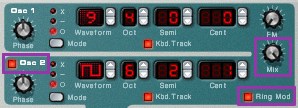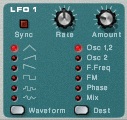Polyphony and Monophonic Legato Mode
The term polyphony, literally meaning “many voices,” refers in synthesizers and samplers to the maximum number of notes you can play simultaneously.
Early synthesizers, like the Moog modular series, could play only one note at a time — they were monophonic. If you held down one key, and then played another key before releasing the first, the first note would cut off suddenly, and you’d hear the second note alone.
The early synths had a feature that helped you to play a single line expressively: portamento — sliding smoothly from one pitch to the next. Using portamento, if you pressed a key before releasing the previous one, the sound would slide from the first note to the second. You could control the speed of the slide.
You can hear a very clear example of this technique near the end of Emerson, Lake, and Palmer’s song, “Lucky Man,” played on a Moog modular system in 1970.
- You make a SubTractor patch monophonic by reducing its
Polyphony to 1. If you want overlapped notes to run
together smoothly, then use Legato mode, rather than
Retrig mode.

Retrigger mode is the default; it restarts the envelopes every time you play a note. Legato mode restarts envelopes only when there is a gap between the release of one note and the attack of the next. If there is not a gap, then the pitch changes when you play a different note, but the envelopes continue their progress as if you were still holding down the first note.

To make the pitch slide from one note to the next, use the Portamento knob to increase the amount of time it takes to slide.
DO THIS: Your patch should be monophonic, with legato mode engaged and a non-zero portamento time.




